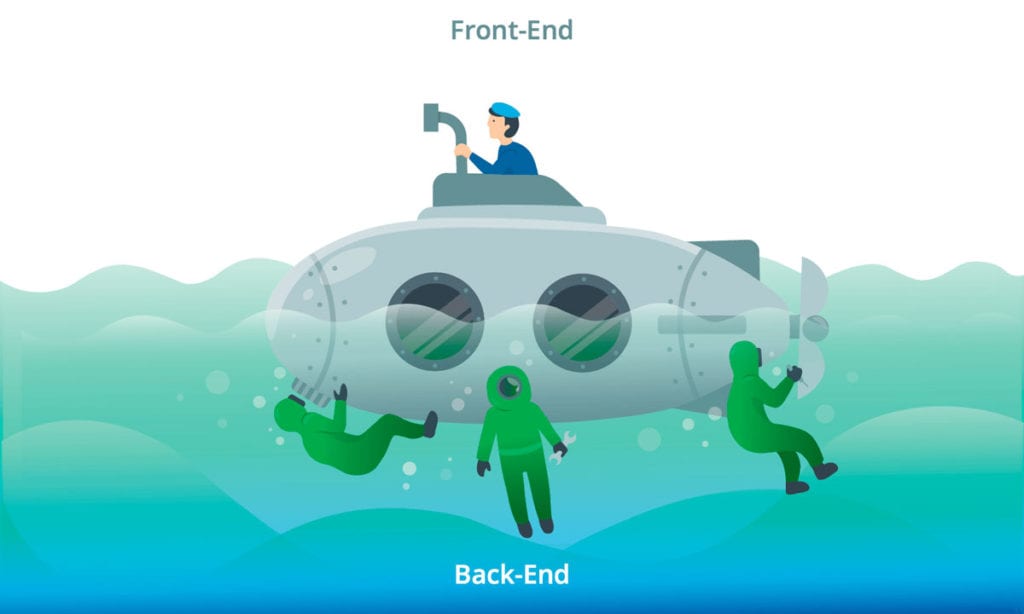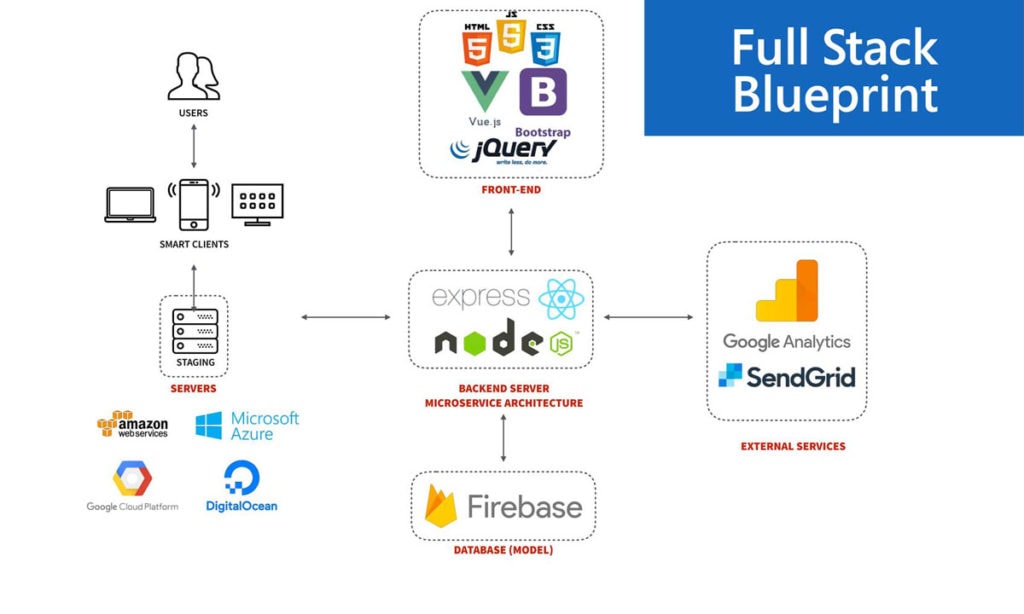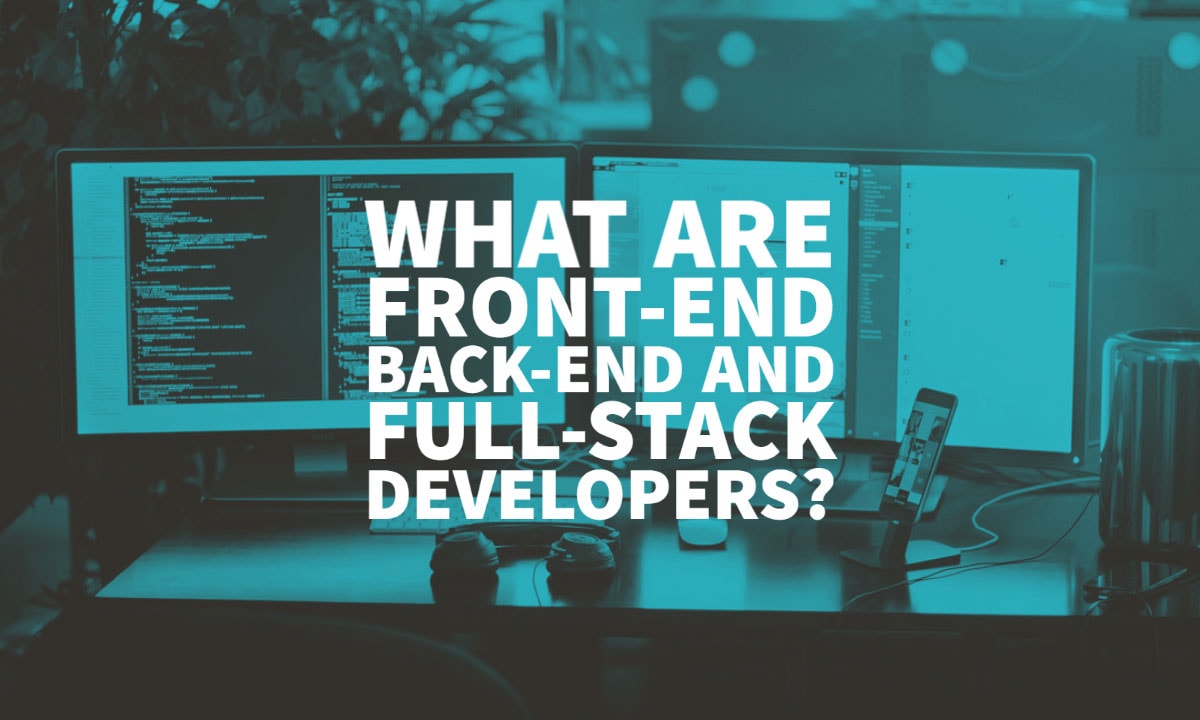
26 May What are Front-End, Back-End And Full-Stack Developers?
What are Front-End, Back-End And Full-Stack Developers?
If you are perceptive like me, you must have noticed the terms “front-end developer,” “back-end developer,” “full stack developer” strewn around almost every job listing online.
They are the people that code, build, analyse and maintain applications, and this is not surprising at all because more businesses encompass the power of the internet every day through the use of websites and mobile apps.
According to Udacity, there are about 1.5 billion websites as of early this year. Sites are crucial for any business that needs to stay in trend, and web developers are always in demand for their services.
Projections state that web development as a job will grow 27 per cent over ten years, faster than the average of other occupations. The next question on your mind would be, “What is a Web Developer, exactly?”
“A Web developer is a kind of programmer who majors in the development of applications that relate to the World Wide Web or distributed network applications. They typically run protocols like HTTP from a Web server to a client browser using associated programming languages like Ruby, HTML/CSS, C#, and PHP, to name a few.”
The jobs of web developers vary, and there are specialisations for particular programming languages. However, they are generally classified into three categories. These are the Front end, Back end, and Full-stack developers. Here, we will explore the differences between the three and the skills needed for each.
Front-End Developers

“Front end” typically referred to as the “client-side” is the content users interact with. It relates to the displayed content when users are navigating the internet from the fonts and colours, the drop-down menus to the transitions, and modals.
A Front-End developer will have to be versed in HTML, CSS, and JavaScript programming to make sure information is presented in the smoothest way as possible to the user.
- HTML (HyperText Markup Language) is the bare skeleton of the web. It is the standard markup language to design documents that are displayed on the web browser. Its current iteration on the internet is HTML5.
- CSS (Cascading Style Sheets) controls the look of the HTML on the page. It sets the colours, fonts, images, and the layout of the page. The current iteration is the CSS3, and features like animation and basic interactivity are introduced.
- JavaScript introduces dynamism to pages by adding special effects, more complex animation, and more interactivity and enables the build of a fully-featured Web application.
In addition to the programming languages, front-end devs need to have a grasp of frameworks like Foundation, Bootstrap, Backbone, AngularJS, and EmberJS.
These ensure the content looks great no matter the device, and libraries like jQuery and LESS help put the code into useful, time-saving form. Ajax is another technique for using JavaScript that dynamically downloads pages by downloading server data in the background.
The side created by them without the back-end input is called the “static side,” and it does not require any information to store in a database. The site will remain the way it is until it is redesigned. “A front-end developer is liable for the interior design of a house that has been built by a back-end developer.”
It is noteworthy that there are other jobs with Front-end titles, of which the main distinction is that they are focused on usability and aesthetics. Front-end devs work closely with these people to bring mockups or wireframes from development to delivery. They include:
- User Interface (UI) Designers: they create the space for interactions between human and machine to occur. They are virtual designers that focus on the design, not its implementation.
- User Experience (UX) Designers: they are involved in the study and research of the path a user takes and its overall effectiveness. They affect changes through testing.
In plain terms: when you engage a site and see its ultra-clean layout and impressive visuals, it was all made possible by a front-end developer. A designer crafts the logo design and graphics, a photographer takes the pictures, and a copywriter writes the text. Still, it all was assembled by a front-end developer who translated it all into web-speak to create the experience you had.
Back-End Developers

You may wonder where all the data used for the front end of the website is stored? That is where the back end comes in.
“Back-End” referred to as the “Server-side” is the guts of the application that lives on the server and is not visible to the user. It comprises a server, an app, and a database. It is primarily ensuring that the right data gets sent to the browser.
A back-end developer builds and maintains the technology that powers those components together; they work hand in hand with front end developers to make their code work and tweak the design where necessary. The security, structure, and content management of the sites is the job of a back-end developer.
The developers use programming languages like PHP, Java, Ruby, Python, or .Net to build an application, which the database understands. They also employ tools like Oracle, MySQL, and SQL Server to write codes that communicate with the server and tell the browser the needed information from the database.
Experience with Linux, Version control software like SVN, CVS or Git, and PHP frameworks like Symfony, Zend, CakePHP are other skills that may be required as back-end devs. These tools are used to write clean, well-documented code to create web applications.
Developers collaborate with business stakeholders to translate their needs into technical requirements to develop the most efficient solution for that technology.
In plain terms: when you navigate a website, information is sent to your device by the servers. Hence, the information that pops up on your screen. When you input your personal information online and the fact you can retrieve it whenever you log in, the entire process is made possible by the back-end developer. Front end developers make the result displayed beautiful and meaningful to you.
Dynamic sites are sites that continuously change and update in real-time. Examples of these are Twitter and Google maps. A dynamic site needs a database to work and store its information, which includes user profiles, images, or posts.
Full Stack Developers

“Stack” means “layer,” and it involves fusing both ends into one.
A Full Stack Developer is best explained as a “Jack of all trades.” The concept is that they can work on both server and client-side and are skilled with multiple frameworks.
A full-stack developer has expertise on both ends and can build a web application from beginning to end. It includes a form of data structuring or modelling, the server, client and hosting, user interface, experience, and business needs.
The job function was popularised about ten years ago by the engineering department of Facebook. “A full-stack programmer is a generalist, someone who can create a non-trivial application by themselves.
People who develop broad skills also tend to build a good mental model of how different layers of a system behave”. The flexibility they provide makes them the most sought of the three by companies because they can bring applications to live entirely on their own. They function as back-end devs on the server-side of web programming and are also fluent in how to control the face of the content on the user’s end like a front-end dev.
Full-Stack Devs should be well-intimated at every level of how the web works; the setup and configuration of Linux, the writing of server-side APIs, using the client-side JavaScript to power an application, and designing using the CSS. Using these tools, they should be able to solve the client-server responsibilities and proffer the costs and benefits of various solutions.
These days, it is not uncommon to find full-stack developers take up skills in visual design, project management, web design, or user experience skills; to have a complete “stack,” so to say.
As time goes by, the distinction between the front end and back end is blurring, and more developers are learning to be “Full Stack’. They are more sought out by business owners who prefer individuals that can take their idea from concept to completion and therefore earn more money than solely front end or back end developers.
Contrary to what many think, full-stack developers do not necessarily write all the codes required for a site, but they are well versed across the entire stack of codes to plunge in when needed. Communication is a soft skill they need to possess because they are often required to work directly with their customers.
Author Bio: Sandra Manson is a passionate journalist who has been contributing to major media publications. She enjoys writing about human phycology and lifestyle. Sandra also runs her blog singlehearts.org, where she covers topics of great interest in modern society.



